令和5年12月16日 土曜日号
“SO-SU-U昆 平成21年”
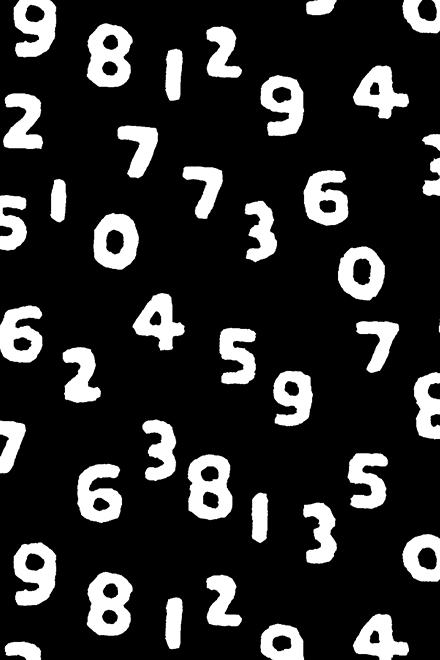
これはたくさんのSO-SU-Uがまじり合って
けじめがつかなくなった状態。
SO-SU-Uの弟分のような柄だと思う。
(脇阪 克二)
SO-SU-U Pals (2009, by Katsuji Wakisaka)
This is a blend of SO-SU-U motifs
that has taken on a random state.
I think this pattern is like the younger brother of SO-SU-U.
| English translation by Lala Fu |
SO-SO-U Kon (2009 par Katsuji Wakisaka)
C'est un mélange de plusieurs motifs SO-SU-U,
placés ça et là, de façon désordonnée.
Pour moi, c’est un peu le petit frère du modèle SO-SU-U.
| Traduction francaise par JB&B |
SO-SU-U十數 昆 (2009, 脇阪 克二)
此圖案是將許多SO-SU-U十數混合在一起,
幾乎看不出界線在哪。
我覺得它就像是SO-SU-U十數的弟弟。
| 中譯 : 莊 幃婷 |
→こちらのテキスタイルデザイン商品
(Textile products with this pattern)
令和5年12月13日 水曜日号
“草花文様 平成24年”

唐草の流れにそって草や花が世界をつくっていく。
草花文様はいつの時代も人々に愛されてきた。
人は木や植物と共に生きている。
植物の文様を見ると人はやさしく受け入れられている気持ちになり安心するのだろう。
(脇阪 克二)
Grasses and Flowers (2012, by Katsuji Wakisaka)
Along the flowing arabesque pattern, I create a world with flowers and grasses.
The motif of grass and flower patterns has been loved by people throughout history.
Human live together with trees and plants.
When we look at patterns inspired by plants,
it may bring a sense of being gently embraced and provide a feeling of reassurance.
| English translation by Karen Yiu |
Motifs fleuris (2012 par Katsuji Wakisaka)
L’herbe ainsi que les fleurs créent un monde au fil de l’arabesque.
Les motifs floraux ont toujours été appréciés des gens.
Les humains vivent avec les arbres et les plantes.
Lorsqu’ils voient des motifs végétaux,
ils se sentent bien acceptés et à l'aise.
| Traduction francaise par JB&B |
草花紋樣 (2012, 脇阪 克二)
以流動的唐草圖案創造了一個草與花的世界
草花紋樣無論在哪個時代都受到人們的喜愛
人類與樹木、植物等一同生活
因此當人們看到植物的紋樣時 會感到溫柔和被接受的安心感吧
| 中譯 : 莊 幃婷 |
令和5年12月09日 土曜日号
“校倉 平成5年”

東大寺の正倉院は現存している数少ない高床式の校倉造り。
三角の断面の木を積み上げた壁は美しいだけでなく機能的。まさに用の美といえる。
千年以上もの間、秘宝を守ってきた校倉の壁をイメージした。
(脇阪 克二)
Ancient Warehouse (1993, by Katsuji Wakisaka)
The Shōsōin warehouse in Tōdai-ji Temple
is one of the few remaining examples of a raised-floor warehouse
built in the square log architectural style.
The walls, constructed by stacking triangular cross-sectioned logs, are not only beautiful but also functional.
They exemplify the concept of functional beauty.
This pattern is inspired by the walls of the warehouse
that have protected precious treasures for over a thousand years.
| English translation by Karen Yiu |
Azekura (1993 par Katsuji Wakisaka)
Le Shōsō-in situé au sein du Tōdai-ji
est l’un des derniers bâtiment sur pilotis
à avoir été construit selon la méthode Azekura.
Un mur formé par un empilement de poutres triangulaires
n’est pas seulement beau mais aussi très fonctionnel.
Je peux même dire que c’est la « beauté de l’utile ».
J’ai imaginé ces fameux murs, qui ont protégé des trésors
pendant plus de mille ans.
| Traduction francaise par JB&B |
校倉 (1993, 脇阪 克二)
東大寺的正倉院是現存為數不多的干欄式校倉(傳統倉庫)建築
將斷面為三角形的木頭堆疊而成的牆壁,不僅美觀,更具備實質功能,可稱得上是一種實用之美。
這個圖案以千年來守護著重要寶物的校倉牆壁為形象來設計
| 中譯 : 莊 幃婷 |
令和5年12月06日 水曜日号
“辰 令和5年”

中国では辰(龍)は権力の
象徴とされ 縁起の良い生き物と
されてきました
日本でも 禅宗のお寺の本堂の
天井画は龍ですし
ふすま絵にも 龍の絵がたくさん
残っています
どうか 皆様の辰年が
縁起のよい一年でありますように
(脇阪 克二)
Dragon (2023, by Katsuji Wakisaka)
In China, dragon is perceived as the symbol of power
and an auspicious creature.
In Japan, the ceilings of Zen Buddhist temples are painted with dragons.
Many dragon drawings remain on the fusuma sliding doors too.
I wish everyone a fortunate Year of the Dragon.
| English translation by Lala Fu |
Dragon (2023 par Katsuji Wakisaka)
En Chine, le dragon est
un symbole de puissance et est considéré
comme une créature de bonne augure.
Au Japon aussi, les peintures des plafonds de la salle principale
des temple Zen représentent des dragons.
Sur les portes coulissantes également,
il y a toujours de nombreuses représentations de dragons.
Que cette année du dragon
soit propice pour chacun d'entre vous.
| Traduction francaise par JB&B |
龍 (2023, 脇阪 克二)
龍在中國是權力的象徵
也被認為是吉祥的生物
在日本禪宗的寺廟正殿
天花壁畫上也繪上龍
也有大量繪有龍的隔扇門留傳後世
希望大家的龍年
會是美好的一年
| 中譯 : 姚 嘉欣 |
→こちらのテキスタイルデザイン商品
(Textile products with this pattern)
令和5年12月02日 土曜日号
“たてよこ 平成16年”
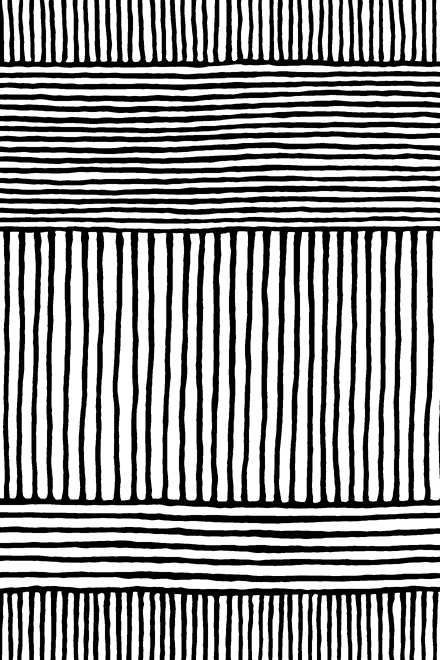
縞は大昔からある永遠の模様。
それを縦横に組み合わせると又、違った世界があらわれてくる。
40年以上、模様にかかわっているけれど、どこにでもある、何でもないモチーフを用いながら、
印象に残る何かをつくっていくことに醍醐味を感じる。
(脇阪 克二)
Length and Breadth (2004, by Katsuji Wakisaka)
Stripes are an eternal pattern that has existed since ancient times.
When combined vertically and horizontally, a different world emerges.
I have been involved with patterns for more than 40 years,
but I find real pleasure in creating somthing memorable
using motifs that are everywhere and ordinary.
| English translation by Karen Yiu |
Dans toutes les directions (2004 par Katsuji Wakisaka)
Les rayures sont un motif intemporel qui existe depuis l’Antiquité.
En combinant des trais verticalement et horizontalement,
un monde différent apparaît.
J’élabore des designs depuis plus de 40 ans,
mais c’est en utilisant des formes ordinaires que l’on trouve partout
que je ressens l’ultime frisson de créer quelque chose qui laissera
la plus belle des impressions.
| Traduction francaise par JB&B |
直線橫線 (2004, 脇阪 克二)
條紋是個永恆的圖案,自古以來就存在
將直線橫線組合起來,又會展現出不同的世界
我從事圖案紋樣設計已超過40年
發現使用普遍常見的圖案
創作出令人印象深刻的作品
反而能感受到真正的樂趣
| 中譯 : 莊 幃婷 |
令和5年11月29日 水曜日号
“家紋 平成17年”
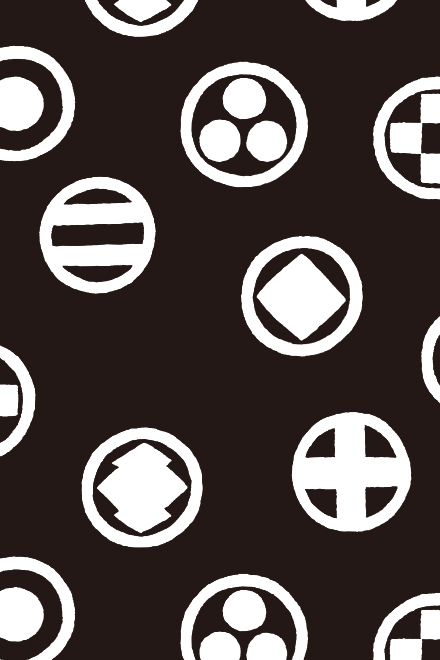
日本の家紋はセンスがいいし、かっこいいなあと思う。
これ以上出来ないというところまでモチーフを凝縮し単純化している。
その中に美しさ、力強さ、しゃれっ気、遊び心などが息づいている。
ひとつひとつの家紋が個性的で自己主張が強い家紋柄では
その雰囲気だけもらって形は単純な幾何柄を組合わせて模様にしてみた。
(脇阪 克二)
Family Crest (2005, by Katsuji Wakisaka)
I think Japanese family crests' designs are cool and have good sense.
The motifs are condensed and simplified to the point where no more can be done.
Beauty, strength, stylishness and a playful spirit are all present in this.
Each family crest is unique and assertive,
so I took only the atmosphere of the family crest,
and combine different simple geometric shapes to create this pattern.
| English translation by Karen Yiu |
Sceau familial (2005 par Katsuji Wakisaka)
Je trouve que les sceaux familiaux japonais sont très stylés.
Leurs motifs sont condensés et simplifiés jusqu’à la limite du possible.
Ils représentent la beauté, la force, la classe ou encore la gaieté.
Chaque sceau est unique, véhiculant un trait de caractère propre à sa maison.
En m’inspirant de ces caractéristiques, j’ai créé un design reprenant des motifs
simplifiés que j’ai assemblé les uns aux autres.
| Traduction francaise par JB&B |
家紋 (2005, 脇阪 克二)
日本的家紋充滿品味 也很帥氣
把一個主題濃縮簡化到極致
其中蘊含優美、力量、時髦和趣味等
每個家紋都獨一無二
將特色強烈的家紋僅取其氛圍
以簡單的幾何形狀組合呈現
完成了這幅圖案
| 中譯 : 莊 幃婷 |
→こちらのテキスタイルデザイン商品
(Textile products with this pattern)
令和5年11月25日 土曜日号
“諸将旌旗図 令和5年”


旌旗とは 旗やのぼり
あるいは軍旗のこと
戦に明け暮れていた時代
戦場で ひときわ目立ち
自分が誰であるか誇示するため
独自の形や 模様を考案し
それを背負って戦った
戦にかける その時代の人々の
息使いが聞こえてくるようでは
ないですか
(脇阪 克二)
Shosho Seiki Zu / Designs of Banners and Standards of Various Generals (2023, by Katsuji Wakisaka)
"Seiki" refers to banners, standards or military flags.
In the period when battles fought through days and nights,
in order to be noticeable and declare oneself in the battlefield,
the generals contrived unique shapes and motifs
and carried them on their backs to fight.
It's like you can almost hear the breath of the warriors of that era, isn't it?
| English translation by Lala Fu |
Bannière des Généraux (2023, par Katsuji Wakisaka)
Le Seiki est un drapeau ou une bannière.
Une sorte d’étendard
utilisée à l’époque des guerres
sur les champs de batailles.
Pour impressionner ses adversaires,
des formes et motifs uniques étaient créées,
le tout porté sur le dos pendant les combats.
Ne peut-on pas presque entendre respirer
ces soldats partant au front?
| Traduction française par JB&B |
諸將旌旗圖 (2023, 脇阪 克二)
旌旗代表的是旗幟或軍旗
在戰火不斷的時代
為了能在 戰場上更加醒目和
彰顯自我身分
各自設計了獨特的形狀和圖案
並且背負著它戰鬥
讓人彷彿可以聽到
生活在戰爭時代的人們的呼吸聲
不是嗎
| 中譯 : 莊 幃婷 |
→こちらのテキスタイルデザイン商品
(Textile products with this pattern)
令和5年11月22日 水曜日号
“花型 令和2年”
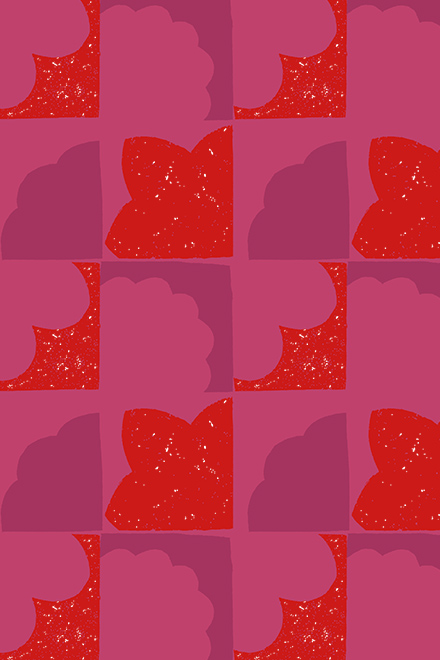
紙を花の形に切ったように描く
ネガ、ポジのような面白さと
間のとり方でリズムが出て
単純だが楽しい模様が出来る
(脇阪 克二)
Shapes of Flowers (2020, by Katsuji Wakisaka)
Drawing motifs like paper cutting flowers.
It is like playing with negatives and positives,
and creating rhythms with empty spaces.
Simple, but it creates fun motifs.
| English translation by Lala Fu |
Formes de fleurs (2020 par Katsuji Wakisaka)
Dessiner une forme de fleur comme pour la découper sur du papier.
L’intérêt du positif, négatif
donne un rythme dans la façon de faire les pauses.
Un motif simple mais amusant peut être créé.
| Traduction francaise par JB&B |
花型 (2020, 脇阪 克二)
繪畫如紙剪花般的圖案
變成類似底片正片和負片的有趣效果
並透過留白的方式產生節奏感
一幅簡單又有趣的圖案就此完成
| 中譯 : 莊 幃婷 |
→こちらのテキスタイルデザイン商品
(Textile products with this pattern)
令和5年11月18日 土曜日号
“格子あそび 平成21年”
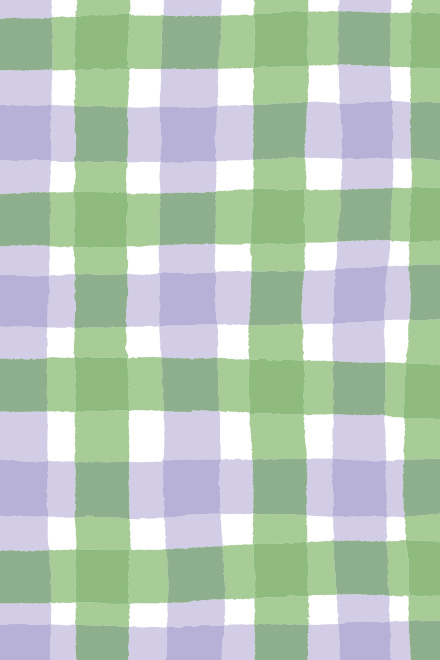
たてとよこに線を引くだけで柄になる。気分によって太くなったり細くしたり。
色を付けてもまた楽しい。
そうやって遊んでいる時に良いものができるものだ。
(脇阪 克二)
Grid Play (2009, by Katsuji Wakisaka)
By just drawing vertical and horizontal lines, a motif can be created.
Depending on the mood at that moment,
the lines can be thicker or thinner,
and it is also fun to fill in colors.
In this way, playing in the creative process can lead to great work.
| English translation by Lala Fu |
Jeux de hachures (2009 par Katsuji Wakisaka)
Dessiner simplement des lignes horizontales et verticales pour créer un motif.
Faites-le plus ou moins épais selon votre humeur.
C’est aussi très amusant à colorier.
Vous pouvez réaliser de belles choses en vous amusant de la sorte.
| Traduction francaise par JB&B |
格子遊戲 (2009, 脇阪 克二)
只要畫出直線和橫線就能成為一個圖案。隨著心情,還可以改變線的粗細,如果加上顏色又是另一種樂趣。
以這種遊戲的方式創作時就會出現好作品。
| 中譯 : 莊 幃婷 |
令和5年11月14日 火曜日号
“茶花 令和5年”


茶花は 茶室の床に飾る花.
千利休による
「花は野にあるように」という
教えから 山野に自生している
花を 生けることが多い
満開のものではなく
つぼみや もうすぐ開くものを選び
時の 移ろいや 風情を表わし
お茶の席を 彩ります
(脇阪 克二)
Chabana / Tea Flowers (2023, by Katsuji Wakisaka)
Tea flowers are flowers that decorate the "tokonoma (alcove)" of a Japanese tea room.
From the teachings of Sen no Rikyu, "let the flowers live the way as they are living in the wild spaces",
it is common to arrange flowers that grow in the wild.
Instead of choosing those in full bloom, buds and flowering ones are picked,
coloring the ceremony space with the passage of time and a special mood.
| English translation by Lala Fu |
Chabana (2023, par Katsuji Wakisaka)
Le chabana est un arrangement floral exposé sur le sol des salons de thé.
D’après l’enseignement de Sen no Rikyū, grand maître de cérémonie du thé,
ces fleurs poussent naturellement dans les champs et les montagnes.
Il faut arranger les végétaux non pas en pleine floraison,
mais choisir plutôt des bourgeons ou des boutons à peine ouverts.
L’objectif est de représenter le temps qui passe et l’élégance,
tout en donnant de la couleur à la cérémonie du thé.
| Traduction française par JB&B |
茶花 (2023, 脇阪 克二)
茶花是裝飾於茶室床之間的花卉
由於千利休曾說過
「讓花有如生長於自然山野間」
因此茶道插花多使用在山林中的野生花朵
並且非盛開狀態
而是選擇含苞或即將綻放的花朵
藉此表現時間的流逝和季節風情
也為茶席增添了色彩
| 中譯 : 莊 幃婷 |
→こちらのテキスタイルデザイン商品
(Textile products with this pattern)
令和5年11月11日 土曜日号
“青花 令和3年”

ツユクサの別のよび方だが
ツユクサからとった青色の染料の
こともさす
その染料で絞りや友禅の
下描きを染める
これは出来上った時には
消えてなくなるもので
縁の下の力持ちの役割をしている
(脇阪 克二)
Aobana/ Dayflower (2021, by Katsuji Wakisaka)
Aobana is another way of saying "dayflower",
and it also refers to the blue dye derived from dayflowers.
The pigment is used to dye the rough sketches in tie dye or yuzen dyeing.
Since the dye will disappear from the finished product,
it is acting as an unsung hero.
| English translation by Lala Fu |
Fleur bleue (2021 par Katsuji Wakisaka)
La comméline est l’autre nom de cette fleur
dont on extrait également un colorant bleu.
Cette couleur était très utilisé dans plusieurs techniques
de teintures japonaises comme le shibori ou le yuzen
pour dessiner l’esquisse d’un motif.
Bien que ce trait disparaisse
une fois l’oeuvre terminée,
il joue un rôle indispensable.
| Traduction francaise par JB&B |
青花 (2021, 脇阪 克二)
青花是鴨拓草的別名
也代表從鴨拓草中萃取出的藍色染料
該染料用於紮染或友禪染的草稿刷色和描繪
由於它的顏色會在成品上消失
可說是默默奉獻的無名英雄
| 中譯 : 莊 幃婷 |
→こちらのテキスタイルデザイン商品
(Textile products with this pattern)
令和5年11月08日 水曜日号
“装飾金具 令和4年”

お城やお寺などの門を
しっかり固定するために
金具が使われている
がっちりと作られた機能的な
ものだが 装飾としても美しく
威厳がある
それらの金具の持つ独特の形を
ふまえて 作った文様
(脇阪 克二)
Decorative Metal Fittings (2022, by Katsuji Wakisaka)
Metal fittings are used to hold the doors of castles or temples firmly in place.
They are not only sturdy and functional
but also serve as beautiful and majestic decorations.
This motif was created based on the unique shapes of these metal fittings.
| English translation by Lala Fu |
Ferrures décoratives (2022 par Katsuji Wakisaka)
Pour fixer de façon durable
les portes des châteaux ou des temples,
des charnières métalliques étaient utilisées.
En plus d’être robustes et fonctionnelles,
elles étaient aussi richement décorées.
J’ai créé ce motif en m’inspirant
de leurs formes uniques.
| Traduction francaise par JB&B |
裝飾金具 (2022, 脇阪 克二)
金具是用來牢牢固定城堡和寺廟等大門
的金屬配件
製作嚴謹 不僅具備功能性
作為裝飾也非常美觀
並能營造威嚴與莊重感
這是根據金具的獨特造型
製作而成的圖案
| 中譯 : 莊 幃婷 |
→こちらのテキスタイルデザイン商品
(Textile products with this pattern)
令和5年11月04日 土曜日号
“刃 令和2年”

刀鍛冶によって 精魂込めて
作られた刃
切れ味はもちろんだが より美しく
独自のものを作ろうと技を競い合った
日本の職人の 芸術的感性の
高さが伝わってくる
又 刃は刀の表面に見える
波形の文様をも意味している
(脇阪 克二)
Yaiba/ Blade (2020, by Katsuji Wakisaka)
According to knife craftsmen, working on a knife with all the soul does
not only result in sharp cutting edges,
but it is also a competition between craftsmen in the pursuit of
making more beautiful and authentic knives.
It expresses the high level of artistic sensibility of the craftsmen in Japan.
Besides, the word "yaiba" also means the wavy pattern
which can be seen from the sides of the blade.
| English translation by Lala Fu |
Lame (2020 par Katsuji Wakisaka)
Pour le forgeron, dans une lame qui est fabriquée
en y mettant tout son coeur,
il y a bien sûr le tranchant, mais aussi la beauté.
Chaque artisan rivalise de compétences
pour créer quelque chose d’unique.
Ils y transmettent leur grande sensibilité artistique.
De plus, les stries visibles en forme d’ondes
sur le côté de la lame du sabre ont également une signification.
| Traduction francaise par JB&B |
刀刃 (2020, 脇阪 克二)
由鑄刀師 注入靈魂 傾其所有
鍛造的刀刃
不僅鋒利 也為力求精美
製作者在技術上相互較量
進而打造獨一無二的作品
表現出日本職人 對藝術的高度感性
此外 刃也可代表在刀劍表面所看到的波形圖案
| 中譯 : 莊 幃婷 |
→こちらのテキスタイルデザイン商品
(Textile products with this pattern)
令和5年11月01日 水曜日号
“よろけ縞 平成16年”
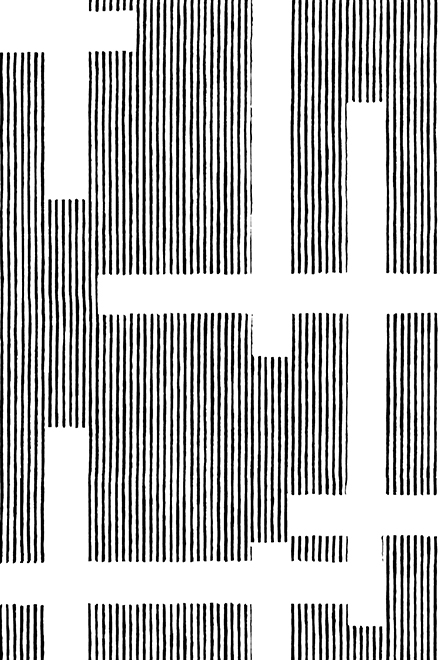
定規を使わず手書きで線を引いていく。
1本1本はよろけているが、全体としては崩れていない。
シンプルで普遍的な、自分らしさのあるデザインだと思っている。
(脇阪 克二)
Staggered Stripes (2004, by Katsuji Wakisaka)
The lines are drawn by hand, without using a ruler.
Each line is staggered, but they look neat as a whole.
I think it is a simple, universal design and
with my own personality.
| English translation by Karen Yiu |
Rayures chancelantes (2004 par Katsuji Wakisaka)
J’ai tracé des traits sans utiliser de règles.
Chaque trait oscille légèrement mais le tout reste équilibré.
Simple et universel, ce design me représente bien.
| Traduction francaise par JB&B |
交錯條紋 (2004, 脇阪 克二)
沒有用尺 直接手畫直線
每一條線都有些搖晃不平整 卻不影響整體
這是一款簡單、普遍又有自己風格的設計
| 中譯 : 莊 幃婷 |
令和5年10月28日 土曜日号
“楓ちらし 平成18年”

楓の葉がヒラヒラと舞い落ちる。
冬がそこまで来ている秋の一日。
(脇阪 克二)
Fallen Maple Leaves (2006, by Katsuji Wakisaka)
Maple leaves fluttering and falling down.
It is a day in autumn when winter is just around the corner.
| English translation by Karen Yiu |
Feuilles d’érable flottantes (2006 par Katsuji Wakisaka)
Les feuilles d’érable descendent le courant.
Une journée automnale qui annonce que
l’hiver approche à grand pas.
| Traduction francaise par JB&B |
楓葉飄飄 (2006, 脇阪 克二)
楓葉輕輕飄落。
這是一個秋天的日子,卻感受到冬天近在眼前。
| 中譯 : 莊 幃婷 |
令和5年10月25日 水曜日号
“縦横無尽 平成5年”

たて よこ ななめ と
あらゆる方向に線が走り
上になり下になり
重なりあいからみあって
模様になっている。
とらわれることなく自由自在だ。
こういうのを縦横無尽というのだろう。
(脇阪 克二)
Freely (1993, by Katsuji Wakisaka)
Lines run in every direction—
vertical, horizontal, and diagonal,
ascending and descending,
overlapping and intertwining, forming a pattern.
It is free and unrestricted, without being bound.
I suppose this is what we call "Juo Mujin"
(being unrestricted, doing things freely).
| English translation by Karen Yiu |
Librement (1993 par Katsuji Wakisaka)
Verticalement, horizontalement,
les lignes partent tous azimut.
En haut, en bas,
se chevauchent et s’enchevêtrent
pour former un motif.
De leur bon gré, à leur façon.
C’est l’image même de la liberté.
| Traduction francaise par JB&B |
自由自在 (1993, 脇阪 克二)
垂直、水平、傾斜
朝著不同方向奔走的線條
上下移動
形成重疊交織的圖案
自由自在、無所拘束
我想這就是日文中的「縱橫無盡」吧
| 中譯 : 莊 幃婷 |
令和5年10月21日 土曜日号
“がんじがらめ 平成24年”

荒い縄でしばりあげられ
がんじがらめになってしまう。
身動きがとれないし息をするのも苦しい。
もがけばもがく程しまってくる。
絶体絶命の危機。
僕はこんな目に合ったことはないが
テキスタイルデザインをつくっていて
どうしてもうまくいかないことがある。
そういう時、自分で自分を
がんじがらめにしていることがある。
自分の気持が変らないと
そこからはなかなかぬけ出せない。
がんじがらめはやっぱりつらい。
(脇阪 克二)
Tied-up (2012, by Katsuji Wakisaka)
Tied up tightly with rough ropes,
unable to move and struggling to breathe.
The more you struggle, the tighter it becomes.
A desperate and hopeless situation.
I have never been in this situation before,
but when I doing textile designs,
there are times when things just don't go well.
At those times, I find myself
tying myself up tightly in knots.
If I don't change my mind,
it is hard to get out of it.
Being tied up like this is truly painful and stressful.
| English translation by Karen Yiu |
Être pieds et poings liés (2012 par Katsuji Wakisaka)
Se sentir comme attaché,
ligoté avec une corde épaisse.
Ne plus pouvoir bouger et avoir du mal à respirer.
Lutter jusqu’à son dernier souffle,
c’est une question de vie ou de mort.
Je n’ai jamais rencontré de telles situations mais
face à mes créations, parfois,
le résultat ne fonctionne pas du tout.
Et c’est dans ces moments-là que je me sens de la sorte.
Si mon ressenti ne change pas,
c’est dur de trouver une solution
et ce sentiment d’être « ligoté » est vraiment insoutenable.
| Traduction francaise par JB&B |
五花大綁 (2012, 脇阪 克二)
粗糙的繩索交錯綁起
成了五花大綁的狀態
身體無法動彈 呼吸困難
越是掙扎 越感到痛苦
已陷入絕望的危機中
我雖從未遇過這樣的情況
但曾經在創作圖案紋樣之時
怎麼都無法順利
此時 心中會把自己捆成
五花大綁的狀態
如果不改變自身想法
就很難從中脫身
被五花大綁真的非常痛苦啊
| 中譯 : 莊 幃婷 |
→こちらのテキスタイルデザイン商品
(Textile products with this pattern)
令和5年10月18日 水曜日号
“ふくれ織 平成4年”
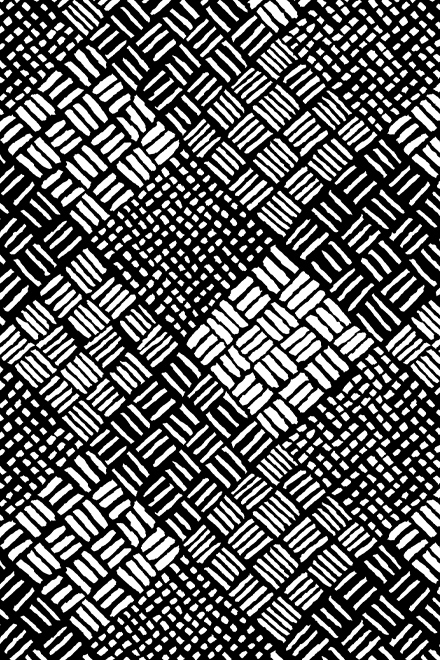
布地のある部分を立体的に盛り上げるふくれ織。
二重織の一種で複雑な行程があるようだ。
平らな部分とふくれた部分で模様をつくっていくことで独特の手触りと面白さが表現される。
このデザインは竹を編んだような模様だがふくれ織りを連想させる。
(脇阪 克二)
Tactual Weaving (1992, by Katsuji Wakisaka)
Tactual weaving is a kind of fabric with raised patterns.
It is a type of double weave
which the production process is said to be complicated.
By creating motifs with the flat and quitted parts,
it gives a unique texture and interesting expressions.
This pattern may look like braided bamboo
but it is reminiscent of tactual weaving.
| English translation by Karen Yiu |
Aspect matelassé (1992 par Katsuji Wakisaka)
Une texture bouffante qui soulève une certaine partie du tissu en relief.
Une sorte de double tissage résultant d’un processus complexe.
Une texture unique intéressante s’exprimant par un motif
composé des parties plates et bombées.
Cette conception rappelle le bambou tissé mais avec un aspect matelassé.
| Traduction francaise par JB&B |
浮雕織 (1992, 脇阪 克二)
布料有部分呈現立體狀態的浮雕織,
是需要複雜工藝的一種雙重編織。
透過平面和凸起部分來創作模樣,
表現出獨特的質感和趣味。
這個看似竹子編織的設計其實讓人聯想到浮雕織。
| 中譯 : 莊 幃婷 |
令和5年10月14日 土曜日号
“鞘 平成10年”
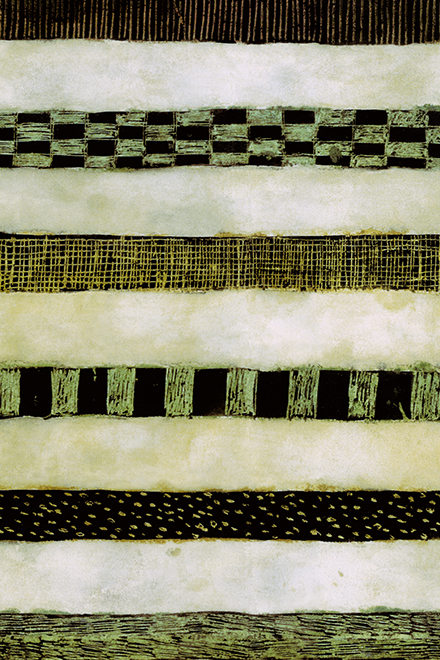
日本刀は戦う道具としてだけでは終らない
刃はもちろん、柄(つか)の部分、鍔、鞘と
技術のかぎりをつくし
想いをこめ、高い精神性と芸術性を
めざしてつくられている
日本刀には武士の魂がこめられている
(脇阪 克二)
Sheath (1998, by Katsuji Wakisaka)
The Japanese sword is more than just a tool for fighting.
The blade, of course, as well as the handle, guard, and sheath,
are all created with the utmost skill,
and is made with the aim of achieving a high level of spirituality and artistry.
The Japanese sword contains the soul of the warrior.
| English translation by Karen Yiu |
Fourreau (1998 par Katsuji Wakisaka)
Les sabres japonais ne sont pas seulement des armes de combat.
La lame, mais aussi le manche, la garde et le fourreau
sont élaborés avec un important degré de technicité,
mais également avec passion, haute spiritualité et
un grand talent artistique.
Les katanas sont imprégnés par l’esprit des samouraïs.
| Traduction francaise par JB&B |
劍鞘 (1998, 脇阪 克二)
日本刀不僅僅是用來戰鬥的武器
除了刀刃之外,刀柄、刀鄂和刀鞘等
都使用了最精湛的技術
並以崇高的精神性和藝術性為目標來製作
日本刀蘊含著武士的精神
| 中譯 : 莊 幃婷 |
令和5年10月11日 水曜日号
“みんな 令和4年”
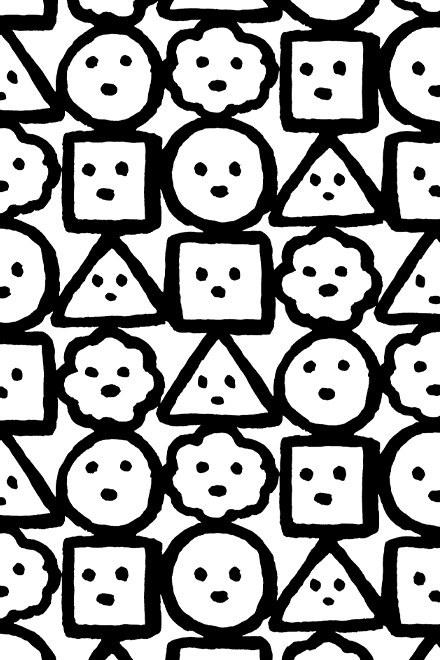
いろんな形をした顔の人が
ずらっと並んで
楽しそうに ほほえんでいます
単純だけど かわいくて
見た人が笑顔になる様なものに
なったと思う
(脇阪 克二)
Everyone (2022, by Katsuji Wakisaka)
Faces in various shapes lined up together.
They seem smiling happily.
Simple but lovely, they have become something
that bring a smile on the faces of people who see them.
| English translation by Lala Fu |
Diversité (2022 par Katsuji Wakisaka)
J’ai aligné des visages de formes variées
qui sourient joyeusement.
Un design simple et mignon
pour faire sourire les gens qui le voient.
| Traduction francaise par JB&B |
大家 (2022, 脇阪 克二)
各種臉型的人
排成一列
看起來很開心地微笑著
這是個簡單卻可愛
而且能讓觀者
會心一笑的作品
| 中譯 : 莊 幃婷 |
→こちらのテキスタイルデザイン商品
(Textile products with this pattern)







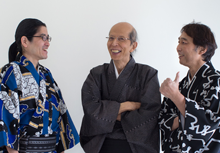

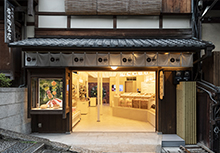

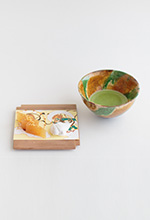
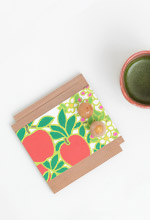
 お問い合わせ窓口
お問い合わせ窓口
What inspired Katsuji Wakisaka to create the SO-SU-U series, and what significance do these patterns hold for him?
visit us Telkom University